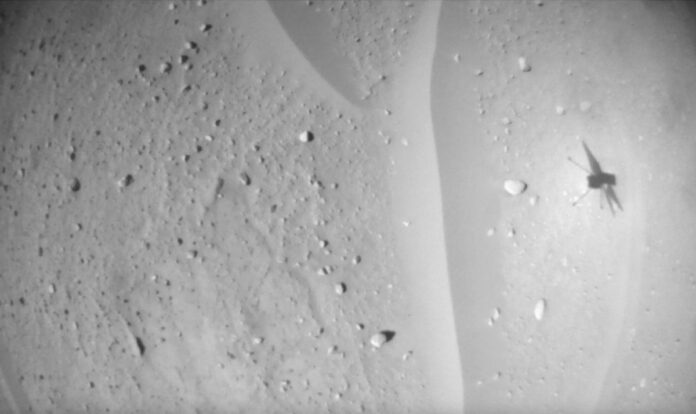NASA’s Ingenuity Mars helicopter made its 48th off-Earth flight on Tuesday (March 21).
Ingenuity buzzed over the Martian landscape at a maximum altitude of around 39 feet (12 meters), observing potential science targets that could be studied by its robotic partner, NASA’s life-hunting Perseverance rover.
Ingenuity traveled at a top speed of 10.4 mph (16.7 kph) during Tuesday’s flight, which covered a horizontal distance of around 1,300 feet (400 meters) and lasted nearly 150 seconds, according to the mission’s flight log.
Related: 12 amazing photos from the Perseverance rover’s 1st year on Mars
The #MarsHelicopter lands another flight!Ingenuity successfully completed Flight 48 yesterday. The rotorcraft reached an altitude of 39 ft (12 meters) and traveled 1,305 ft (398 meters) for 149.9 seconds. https://t.co/7DMHj9LkNX pic.twitter.com/oAl9ZZwx1fMarch 22, 2023
Ingenuity, which in April 2021 became the first machine to achieve powered flight in the skies of an alien world, is now well on its way to a milestone 50th flight.
March has been an important month for Ingenuity and its operators. Not only has the “Marscopter” made its 47th and 48th flights in March, but this month marks exactly one Earth year since the mission of the helicopter was extended by NASA officials.
“Less than a year ago, we didn’t even know if powered, controlled flight of an aircraft at Mars was possible,” then-NASA science chief Thomas Zurbuchen said in March 2022 (opens in new tab). “Now, we are looking forward to Ingenuity’s involvement in Perseverance’s second science campaign. Such a transformation of mindset in such a short period is simply amazing, and one of the most historic in the annals of air and space exploration.”
Ingenuity touched down on the Martian surface with Perseverance on Feb. 18, 2021. The helicopter, which weighs less than 4 pounds (1.8 kilograms), couldn’t take to the Martian skies straightaway, however. It had to wait for Perseverance to carry it to a suitable “airfield” on Mars.
The rover reached such a site in April of that year, which NASA scientists named “Wright Brothers Field” in honor of aircraft pioneers Orville and Wilbur Wright, who are credited with making the first controlled, sustained flight of a powered, heavier-than-air aircraft here on Earth on Dec. 17, 1903.
On its 58th Earth day on the Red Planet, Ingenuity made its debut self-powered and self-controlled flight. During the flight, Ingenuity climbed to an altitude of just 10 feet (3 m), staying aloft in the thin Martian atmosphere for almost 40 seconds but not traveling horizontally, instead landing back in the same spot from which it lifted off.
Just three days later, on April 22, 2021, the helicopter made its second flight and its first horizontal jaunt across Mars, flying 13 feet (4 m) at an altitude of 16 feet (5 m) and staying airborne for around 52 seconds.
As of its most recent flight, Ingenuity has traveled a total of around 36,000 feet (11,000 m) across the Martian landscape, according to the flight log. The helicopter has reached a maximum altitude of 46 feet (14 m) and has hit a maximum speed of around 13.4 mph (21.6 kph). Its total time in the air is around 84 minutes.
Achieving such feats on the Red Planet takes a special craft indeed. Not only did Ingenuity have to be designed to be light yet strong enough to withstand the harsh conditions of Mars, but the helicopter also had to have enough power to take off in the Martian atmosphere, which is just 1% as thick as Earth’s. This power is delivered by Ingenuity’s counter-rotating blades that spin about 2,500 revolutions per minute (opens in new tab) (RPM). By comparison, an average helicopter’s blades here on Earth spin at 400 to 500 RPM.
Ingenuity and Perseverance are exploring an area of Mars known as Jezero Crater, a region containing an ancient lake bed and river delta that around 3.5 billion years ago held lots of liquid water. NASA picked Jezero for Perseverance’s mission chiefly because of the crater’s past life-hosting potential.
Follow us on Twitter @Spacedotcom (opens in new tab) or Facebook (opens in new tab).

